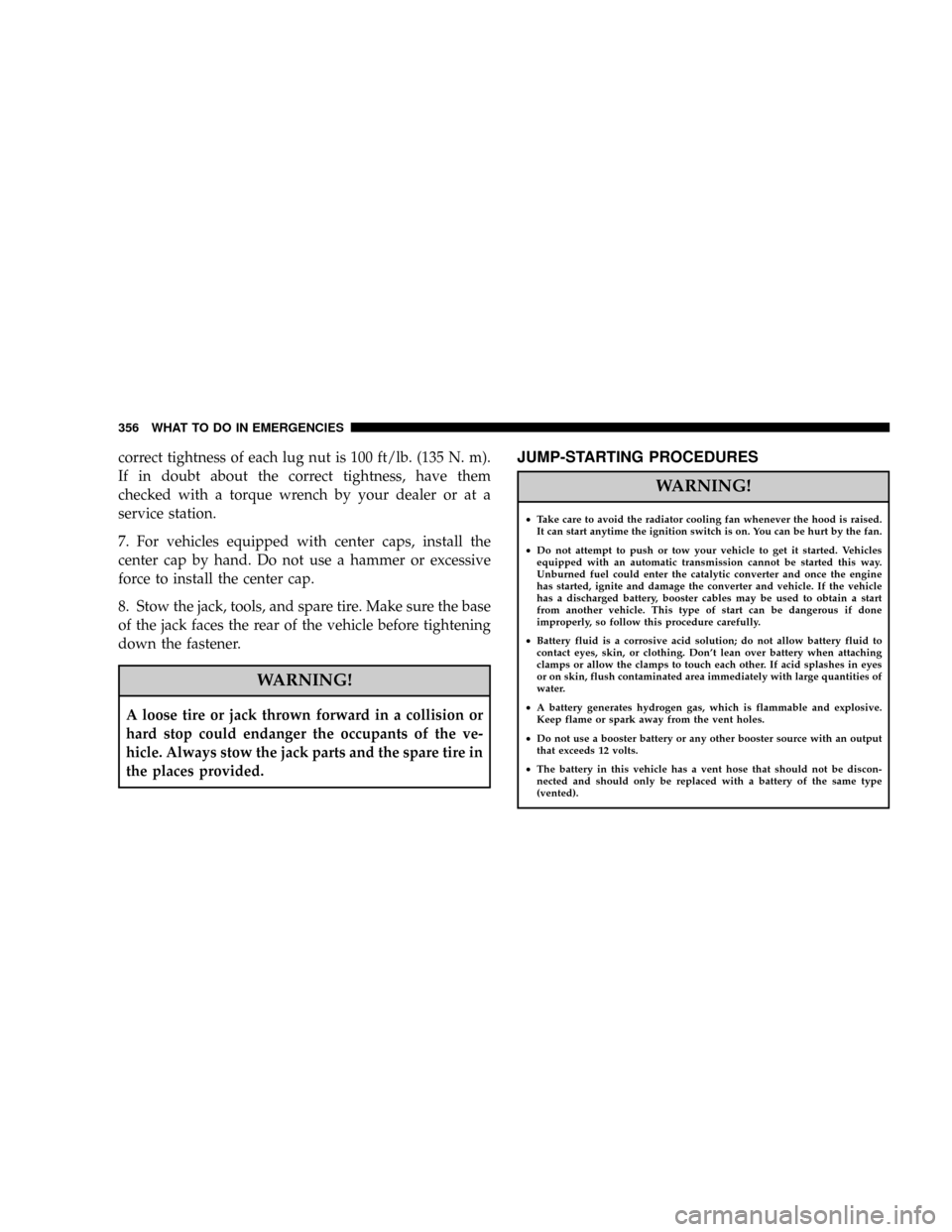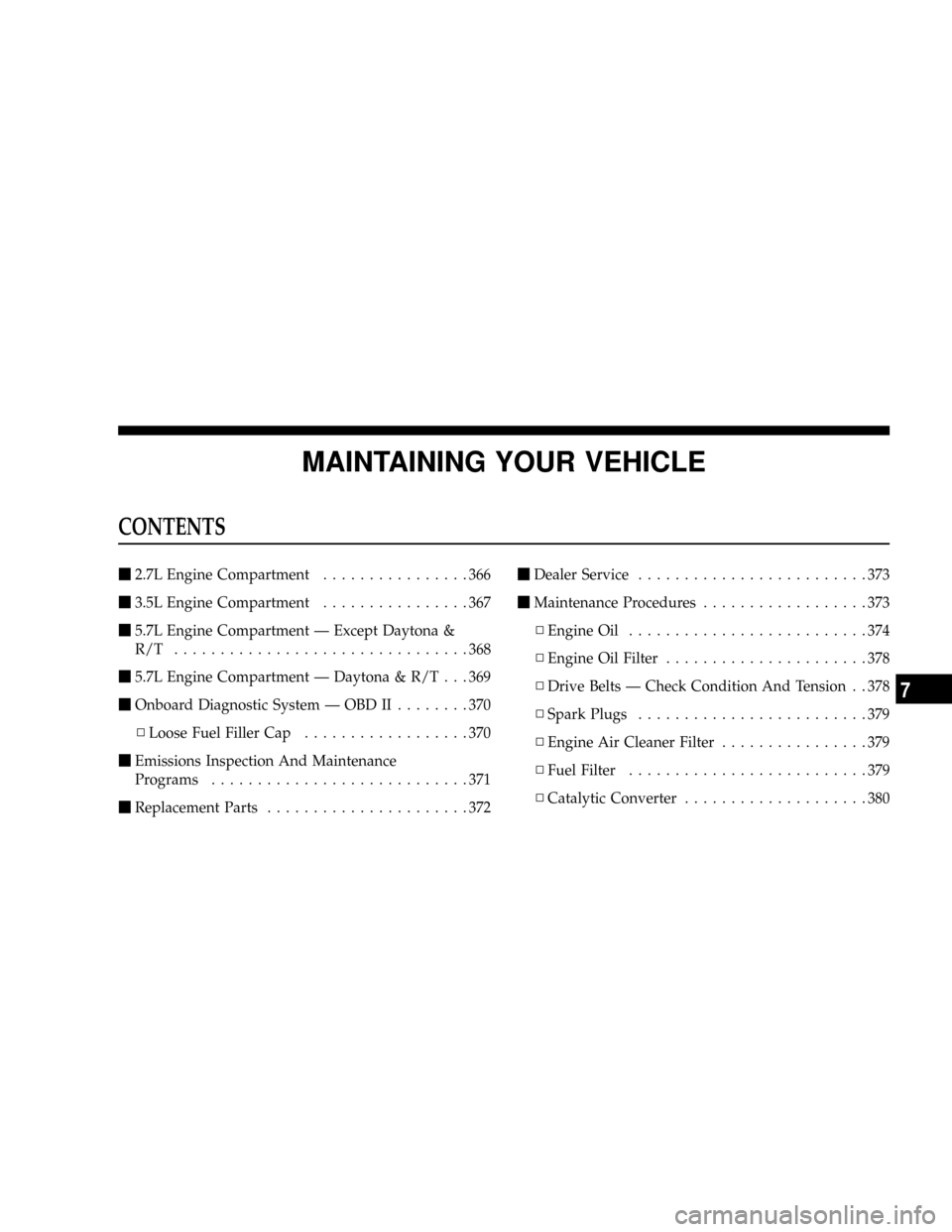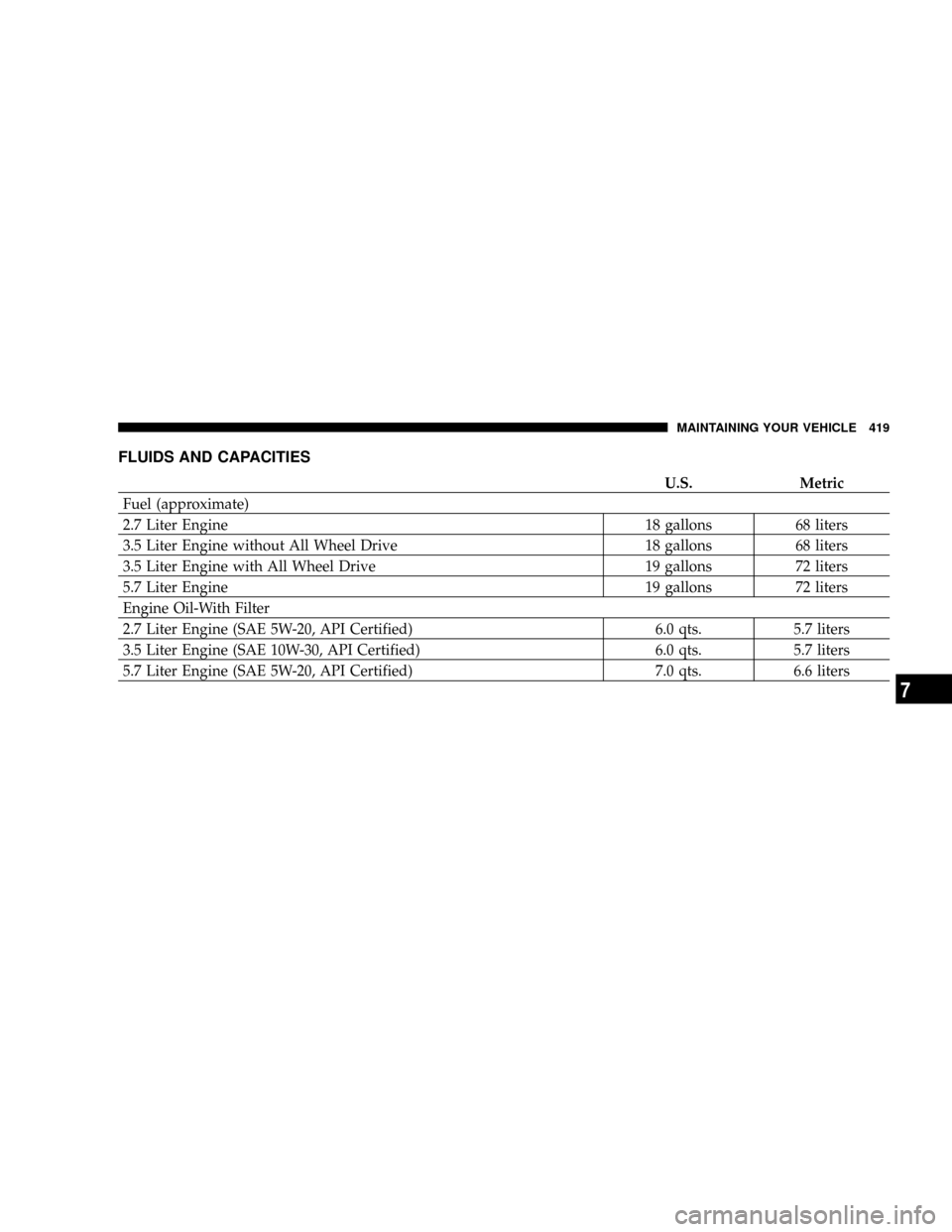2008 DODGE CHARGER fuel cap
[x] Cancel search: fuel capPage 356 of 466

correct tightness of each lug nut is 100 ft/lb. (135 N. m).
If in doubt about the correct tightness, have them
checked with a torque wrench by your dealer or at a
service station.
7. For vehicles equipped with center caps, install the
center cap by hand. Do not use a hammer or excessive
force to install the center cap.
8. Stow the jack, tools, and spare tire. Make sure the base
of the jack faces the rear of the vehicle before tightening
down the fastener.
WARNING!
A loose tire or jack thrown forward in a collision or
hard stop could endanger the occupants of the ve-
hicle. Always stow the jack parts and the spare tire in
the places provided.
JUMP-STARTING PROCEDURES
WARNING!
²Take care to avoid the radiator cooling fan whenever the hood is raised.
It can start anytime the ignition switch is on. You can be hurt by the fan.
²Do not attempt to push or tow your vehicle to get it started. Vehicles
equipped with an automatic transmission cannot be started this way.
Unburned fuel could enter the catalytic converter and once the engine
has started, ignite and damage the converter and vehicle. If the vehicle
has a discharged battery, booster cables may be used to obtain a start
from another vehicle. This type of start can be dangerous if done
improperly, so follow this procedure carefully.
²Battery fluid is a corrosive acid solution; do not allow battery fluid to
contact eyes, skin, or clothing. Don't lean over battery when attaching
clamps or allow the clamps to touch each other. If acid splashes in eyes
or on skin, flush contaminated area immediately with large quantities of
water.
²A battery generates hydrogen gas, which is flammable and explosive.
Keep flame or spark away from the vent holes.
²Do not use a booster battery or any other booster source with an output
that exceeds 12 volts.
²The battery in this vehicle has a vent hose that should not be discon-
nected and should only be replaced with a battery of the same type
(vented).
356 WHAT TO DO IN EMERGENCIES
Page 363 of 466

MAINTAINING YOUR VEHICLE
CONTENTS
m2.7L Engine Compartment................366
m3.5L Engine Compartment................367
m5.7L Engine Compartment Ð Except Daytona &
R/T ................................368
m5.7L Engine Compartment Ð Daytona & R/T . . . 369
mOnboard Diagnostic System Ð OBD II........370
NLoose Fuel Filler Cap..................370
mEmissions Inspection And Maintenance
Programs............................371
mReplacement Parts......................372mDealer Service.........................373
mMaintenance Procedures..................373
NEngine Oil..........................374
NEngine Oil Filter......................378
NDrive Belts Ð Check Condition And Tension . . 378
NSpark Plugs.........................379
NEngine Air Cleaner Filter................379
NFuel Filter..........................379
NCatalytic Converter....................380
7
Page 370 of 466

ONBOARD DIAGNOSTIC SYSTEM Ð OBD II
Your vehicle is equipped with a sophisticated onboard
diagnostic system called OBD II. This system monitors
the performance of the emissions, engine, and automatic
transmission control systems. When these systems are
operating properly, your vehicle will provide excellent
performance and fuel economy, as well as engine emis-
sions well within current government regulations.
If any of these systems require service, the OBD II system
will turn on the ªMalfunction Indicator Light.º It will
also store diagnostic codes and other information to
assist your service technician in making repairs. Al-
though your vehicle will usually be drivable and not
need towing, see your dealer for service as soon as
possible.CAUTION!
Prolonged driving with the ªMalfunction Indicator
Lightº on could cause further damage to the emission
control system. It could also affect fuel economy and
driveability. The vehicle must be serviced before any
emissions tests can be performed.
If the ªMalfunction Indicator Lightº is flashing
while the engine is running, severe catalytic con-
verter damage and power loss will soon occur. Im-
mediate service is required.
Loose Fuel Filler Cap
If the vehicle diagnostic system determines that the fuel
filler cap is loose, improperly installed, or damaged, a
ªCheck Gascapº message will display in the Electronic
Vehicle Information Center (EVIC) Ð if equipped. If this
occurs, tighten the fuel filler cap properly and press the
370 MAINTAINING YOUR VEHICLE
Page 371 of 466

odometer reset button to turn off the message. If the
problem continues, the message will appear the next time
the vehicle is started.
A loose, improperly installed, or damaged fuel filler cap
may also turn on the Malfunction Indicator Light (MIL).
EMISSIONS INSPECTION AND MAINTENANCE
PROGRAMS
In some localities, it may be a legal requirement to pass
an inspection of your vehicle's emissions control system.
Failure to pass could prevent vehicle registration.
For states, which have an I/M (Inspection and
Maintenance) requirement, this check verifies the
following: the MIL (Malfunction Indicator Light)
is functioning and is not on when the engine is running,
and that the OBD (On Board Diagnostic) system is ready
for testing.Normally, the OBD system will be ready. The OBD
system maynotbe ready if your vehicle was recently
serviced, if you recently had a dead battery, or a battery
replacement. If the OBD system should be determined
not ready for the I/M test, your vehicle may fail the test.
Your vehicle has a simple ignition key actuated test,
which you can use prior to going to the test station. To
check if your vehicle's OBD system is ready, you must do
the following:
1. Insert your ignition key into the ignition switch.
2. Turn the ignition to the ON position, but do not crank
or start the engine.
3. If you crank or start the engine, you will have to start
this test over.
4. As soon as you turn your key to the ON position, you
will see your MIL symbol come on as part of a normal
bulb check.
MAINTAINING YOUR VEHICLE 371
7
Page 419 of 466

FLUIDS AND CAPACITIES
U.S. Metric
Fuel (approximate)
2.7 Liter Engine 18 gallons 68 liters
3.5 Liter Engine without All Wheel Drive 18 gallons 68 liters
3.5 Liter Engine with All Wheel Drive 19 gallons 72 liters
5.7 Liter Engine 19 gallons 72 liters
Engine Oil-With Filter
2.7 Liter Engine (SAE 5W-20, API Certified) 6.0 qts. 5.7 liters
3.5 Liter Engine (SAE 10W-30, API Certified) 6.0 qts. 5.7 liters
5.7 Liter Engine (SAE 5W-20, API Certified) 7.0 qts. 6.6 liters
MAINTAINING YOUR VEHICLE 419
7
Page 446 of 466

B-Pillar Location........................ 294
Brake Assist System...................... 285
Brake Control System, Electronic............. 285
Brake Fluid............................ 423
Brake, Parking.......................... 278
Brake System........................280,394
Anti-Lock (ABS)....................... 280
Fluid Check.......................395,423
Hoses.............................. 394
Master Cylinder....................... 395
Parking............................. 278
Warning Light.....................170,280
Brakes.............................280,394
Brake/Transmission Interlock............... 261
Break-In Recommendations, New Vehicle........ 74
Brightness, Interior Lights.................. 129
Bulb Replacement.....................412,413
Bulbs, Light..........................78,412Calibration, Compass..................... 182
Capacities, Fluid........................ 419
Caps, Filler
Fuel................................ 323
Oil (Engine).......................376,377
Radiator (Coolant Pressure)............... 390
Car Washes............................ 399
Carbon Monoxide Warning...............75,322
Cargo (Vehicle Loading)................... 326
Catalytic Converter...................... 380
CD (Compact Disc) Player...............191,209
Cellular Phone.....................87,209,211
Certification Label....................... 326
Chains, Tire............................ 307
Changing A Flat Tire..................... 346
Chart, Tire Sizing........................ 291
Check Engine Light (Malfunction Indicator
Light)................................ 371
Checking Your Vehicle For Safety............. 75
446 INDEX
Page 447 of 466

Checks, Safety........................... 75
Child Restraint..................65,66,67,70,72
Child Restraint Tether Anchors.............68,70
Child Safety Locks........................ 32
Clean Air Gasoline....................... 320
Cleaning
Wheels............................. 401
Windshield Wiper Blades................. 386
Climate Control......................... 239
Clock........................192,196,211,215
Coin Holder........................... 153
Cold Weather Operation................... 256
Compact Disc (CD) Maintenance............. 238
Compact Spare Tire...................... 302
Compass.............................. 181
Compass Calibration..................... 182
Compass Variance....................... 182
Computer, Trip/Travel.................... 178Connector
UCI ................................ 232
Universal Consumer Interface (UCI)......... 232
Conserving Fuel........................ 178
Console, Floor.......................... 153
Console, Overhead....................... 138
Contract, Service........................ 436
Converter, Catalytic...................... 380
Coolant Pressure Cap (Radiator Cap).......... 390
Cooling System......................... 388
Adding Coolant (Antifreeze).............. 390
Coolant Capacity...................... 419
Coolant Level......................388,391
Disposal of Used Coolant................ 391
Drain, Flush, and Refill.................. 389
Inspection........................... 391
Points to Remember.................... 392
Pressure Cap......................... 390
Radiator Cap......................... 390
INDEX 447
10
Page 449 of 466

Electrical Power Outlets................... 149
Electronic Brake Control System
Brake Assist System.................... 285
Electronic Stability Program............... 286
Traction Control System................. 284
Electronic Power Distribution Center (Fuses).... 404
Electronic Speed Control (Cruise Control)...... 135
Electronic Stability Program (ESP)............ 286
Electronic Throttle Control Warning Light...... 165
Electronic Vehicle Information Center (EVIC).... 175
Emergency Deck Lid Release................ 40
Emergency, In Case of
Freeing Vehicle When Stuck............... 359
Hazard Warning Flasher................. 344
Jacking............................. 346
Jump Starting......................... 356
Overheating.......................... 345
Towing............................. 360
Emergency Trunk Release................... 40Emission Control System Maintenance......371,426
Engine.....................74,366,367,368,369
Air Cleaner.......................... 379
Block Heater......................... 258
Break-In Recommendations................ 74
Checking Oil Level..................374,375
Compartment................366,367,368,369
Coolant (Antifreeze).................388,421
Cooling............................. 388
Exhaust Gas Caution..................75,322
Fails to Start.......................... 257
Flooded, Starting...................... 257
Fuel Requirements..................... 319
Jump Starting......................... 356
Multi-Displacement..................... 283
Oil ...........................374,419,421
Oil Change Interval...............169,178,376
Oil Filler Cap......................376,377
Oil Filter............................ 378
INDEX 449
10